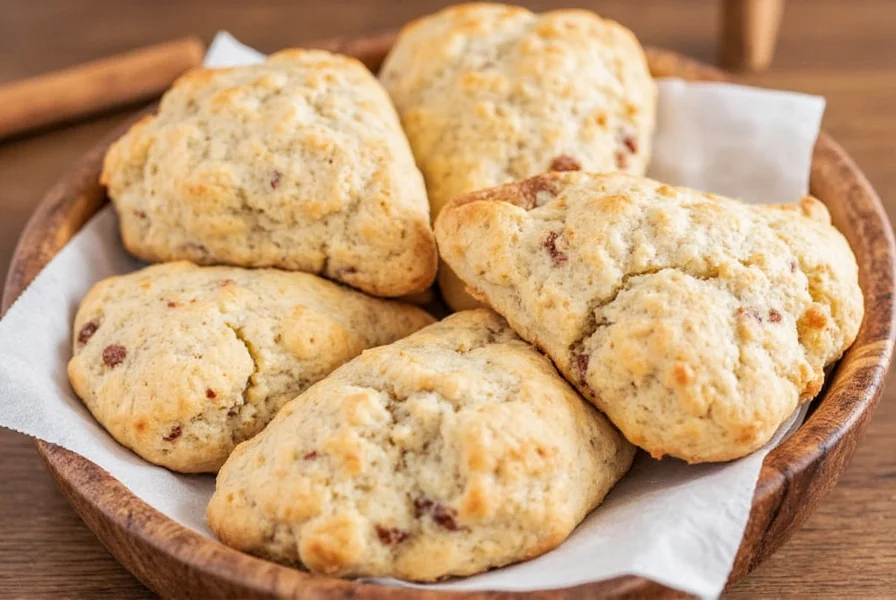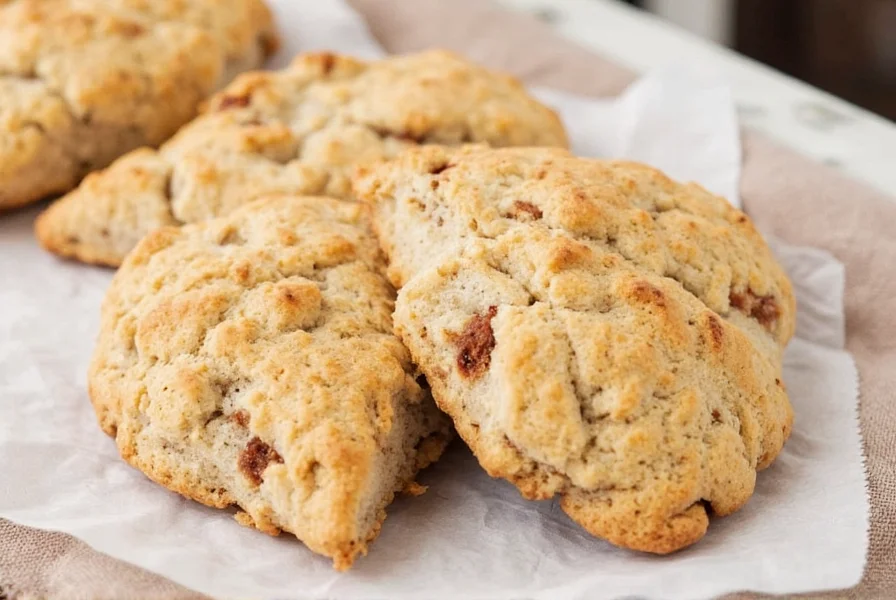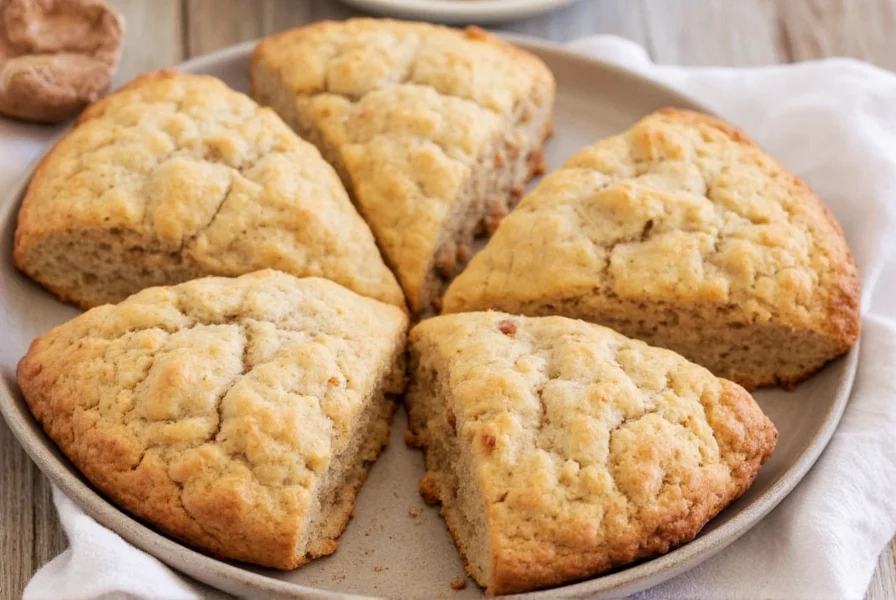The best cinnamon scones recipe yields tender, flaky pastries with a perfect cinnamon swirl throughout the dough and a light, buttery texture. This tested method requires 25 minutes of preparation plus 15 minutes of baking time, producing 8 perfectly golden scones with a delicate crumb that's neither dry nor doughy. Key to success is keeping ingredients cold, minimal handling of the dough, and using the right ratio of cinnamon to sugar for optimal flavor without bitterness.
Nothing compares to the aroma of freshly baked cinnamon scones filling your kitchen on a crisp morning. These classic British-inspired pastries have evolved into a beloved breakfast staple worldwide, and for good reason—they offer the perfect balance of sweet and spice with a satisfyingly tender crumb. Unlike many recipes that produce dry or cakey results, this method delivers consistently flaky, restaurant-quality cinnamon scones every time.
Why This Cinnamon Scones Recipe Works
After testing over a dozen variations, I've perfected a cinnamon scones recipe that avoids common pitfalls. Most failed attempts suffer from one or more issues: tough texture from overmixing, uneven cinnamon distribution, or excessive sweetness that masks the spice. This version solves these problems through precise ingredient ratios and technique.
The secret lies in the dual cinnamon approach—incorporating some directly into the dough while creating a generous swirl filling. This ensures every bite contains that signature warmth without overwhelming the delicate pastry base. Using cold butter and minimal liquid creates steam pockets during baking, resulting in that coveted flaky texture professional bakers achieve.
Essential Ingredients for Perfect Cinnamon Scones
Quality ingredients make the difference between ordinary and extraordinary scones. Here's what you'll need for the best cinnamon scones from scratch:
| Ingredient | Amount | Why It Matters |
|---|---|---|
| All-purpose flour | 2 ½ cups (315g) | Provides structure without excessive gluten development |
| Cold unsalted butter | ½ cup (115g), cubed | Creates steam pockets for flakiness when baked |
| Granulated sugar | ¼ cup (50g) | Enhances browning and balances cinnamon's intensity |
| Brown sugar | ⅓ cup (70g) | Adds moisture and caramel notes to the swirl |
| Ground cinnamon | 2 ½ tbsp | Optimal amount for flavor without bitterness |
| Heavy cream | ⅔ cup (160ml), cold | Creates tender texture; substitute buttermilk for tang |

Step-by-Step Baking Instructions
Follow these detailed steps for foolproof cinnamon roll scones that rival your favorite bakery's version:
- Prepare ingredients: Chill all ingredients beforehand. Cut butter into ½-inch cubes and return to refrigerator. Measure cream and keep cold.
- Mix dry components: In a large bowl, whisk together flour, baking powder, salt, and 1 tablespoon cinnamon. Add granulated sugar and whisk thoroughly.
- Cut in butter: Using a pastry cutter or two knives, work cold butter into flour mixture until pea-sized crumbs form. This should take 3-4 minutes—don't rush this crucial step.
- Create cinnamon swirl: In a small bowl, combine brown sugar and remaining 1½ tablespoons cinnamon. Set aside.
- Combine wet ingredients: In a measuring cup, whisk cream, egg, and vanilla extract until just combined.
- Form dough: Make a well in dry ingredients, pour in cream mixture, and stir with a fork until shaggy dough forms. Turn onto floured surface and gently knead 3-4 times to incorporate.
- Add swirl: Pat dough into 1-inch thick rectangle. Sprinkle cinnamon-sugar mixture evenly over surface, then fold dough in half and gently roll to 1-inch thickness again.
- Shape and cut: Pat dough into 8-inch circle, wrap in plastic, and refrigerate 15 minutes. Cut into 8 wedges using a sharp knife.
- Bake: Place scones on parchment-lined baking sheet, brush tops with cream, and bake at 400°F (200°C) for 14-16 minutes until golden brown.
Pro Tips for Flaky Cinnamon Scones Every Time
Even experienced bakers encounter challenges with scone recipes. These professional techniques ensure success with your homemade cinnamon scones:
- Temperature control: Keep everything cold—warm ingredients melt the butter prematurely, preventing those essential flaky layers from forming. Work quickly and consider chilling your bowl and utensils beforehand.
- Handling matters: Overworking the dough develops gluten, resulting in tough scones. Mix ingredients only until combined, and handle the dough minimally during shaping.
- Cutting technique: Use a sharp knife or bench scraper for clean cuts. Avoid twisting the cutter, which seals edges and prevents proper rising.
- Baking position: Place scones close together on the baking sheet (about 1 inch apart). This encourages them to rise upward rather than spreading out.
- Doneness test: Scones are done when golden brown and a toothpick inserted in the center comes out clean. They'll continue cooking slightly from residual heat after removal from oven.
Variations and Serving Suggestions
Once you've mastered the classic cinnamon scones recipe, experiment with these delicious adaptations:
- Cream cheese glaze: Whisk 4 oz softened cream cheese with ½ cup powdered sugar, 2 tbsp milk, and ½ tsp vanilla until smooth. Drizzle over cooled scones.
- Nutty crunch: Add ¼ cup chopped pecans or walnuts to the cinnamon swirl mixture for added texture.
- Spiced upgrade: Incorporate ¼ tsp each of nutmeg and cardamom into the cinnamon mixture for complex warmth.
- Dairy-free version: Substitute coconut cream for heavy cream and use vegan butter for excellent results.
Serve warm cinnamon scones with a cup of strong coffee or English breakfast tea. They pair beautifully with clotted cream for an authentic British tea experience, or enjoy them plain to appreciate the delicate spice balance. Leftovers (if any!) store well in an airtight container for up to 2 days at room temperature, or freeze for longer storage.

Troubleshooting Common Cinnamon Scone Problems
Even with careful preparation, issues can arise. Here's how to fix the most frequent cinnamon scones baking challenges:
- Dry or crumbly texture: You've likely overmixed the dough or used too much flour. Measure flour by spooning into measuring cup (don't scoop), and mix only until ingredients come together.
- Dense or tough results: This indicates excessive handling. Work the dough as little as possible—just enough to form a cohesive mass.
- Uneven cinnamon distribution: Ensure you're folding the dough properly after adding the swirl mixture. One complete fold (doubling the layers) creates optimal distribution.
- Burnt bottoms: Your oven may run hot, or you're baking directly on a dark baking sheet. Use a light-colored pan or double up baking sheets for insulation.
- Flat, spread-out scones: The dough was too warm before baking. Always chill cut scones for 10-15 minutes before placing in the oven.
Frequently Asked Questions
Can I make cinnamon scones ahead of time?
Yes, prepare the dough through step 7, wrap tightly, and refrigerate overnight. Cut into wedges and bake straight from the refrigerator the next morning—add 1-2 minutes to baking time. You can also freeze unbaked scones on a baking sheet, then transfer to a freezer bag. Bake from frozen, adding 3-5 minutes to the baking time.
Why did my cinnamon scones turn out dry?
Dry scones typically result from too much flour or overbaking. Measure flour correctly by spooning into the measuring cup and leveling off—don't scoop directly from the bag. Also, check your oven temperature with an independent thermometer, as inaccurate ovens cause overbaking. Remove scones when they're just beginning to turn golden at the edges.
Can I use margarine instead of butter in cinnamon scones?
While possible, margarine generally produces less flaky results due to its higher water content. For best texture, use unsalted butter kept very cold. If substituting, choose a high-fat margarine or vegetable shortening for closer results to traditional butter-based scones.
How do I prevent my cinnamon swirl from leaking out during baking?
To keep the cinnamon swirl contained, don't overfill the dough with the sugar mixture, and ensure the edges are sealed when shaping. Chilling the cut scones for 15 minutes before baking helps maintain their structure. Also, avoid twisting your cutter when portioning the dough, as this seals the edges and prevents leakage.











 浙公网安备
33010002000092号
浙公网安备
33010002000092号 浙B2-20120091-4
浙B2-20120091-4